Abstract
Klebsiella pneumoniae is a common pathogen, associated with a wide spectrum of infections, and clinical isolates of K. pneumoniae often possess multiple antibiotic resistances. Here, we describe a novel lytic N4-like bacteriophage KP8, specific to K. pneumoniae, including its genome, partial structural proteome, biological properties, and proposed taxonomy. Electron microscopy revealed that KP8 belongs to the Podoviridae family. The size of the KP8 genome was 73,679 bp, and it comprised 97 putative open reading frames. Comparative genome analysis revealed that the KP8 genome possessed the highest similarity to the genomes of Enquatrovirus and Gamaleyavirus phages, which are N4-like podoviruses. In addition, the KP8 genome showed gene synteny typical of the N4-like podoviruses and contained the gene encoding a large virion-encapsulated RNA polymerase. Phylogenetic analysis of the KP8 genome revealed that the KP8 genome formed a distinct branch within the clade, which included the members of Enquatrovirus and Gamaleyavirus genera besides KP8. The average evolutionary divergences KP8/Enquatrovirus and KP8/Gamaleyavirus were 0.466 and 0.447 substitutions per site (substitutes/site), respectively, similar to that between Enquatrovirus and Gamaleyavirus genera (0.468 substitutes/site). The obtained data suggested that Klebsiella phage KP8 differs from other similar phages and may represent a new genus within the N4-like phages.
1. Introduction
Klebsiella pneumoniae is a Gram-negative, non-motile, non-sporulating bacterium belonging to the Klebsiella genus of the Enterobacteriaceae family. Members of the Klebsiella genus are widespread in nature and found in soil, sewage, plants, and the intestinal tract of humans and animals. K. pneumoniae is a common pathogen, associated with a wide spectrum of infections, such as pneumonia, urinary tract infections, intra-abdominal infections, bloodstream infections, meningitis, and pyogenic liver abscesses [1]. The Klebsiella capsular polysaccharides are one of the major factors of virulence [2] and currently more than 80 variants of Klebsiella capsular types (K-types) are known [3]. Each K-type is associated with particular genes in the cluster of capsular synthesis (cps). The cps cluster has a mosaic structure with a group of six conserved genes (galF, orf2, wzi, wza, wzb, and wzc) at the 5’ end, which may be used for the molecular serotyping of K. pneumoniae strains [4,5]. Clinical isolates of K. pneumoniae, causing severe nosocomial infections, often possess multiple antibiotic resistances [6,7,8]. During the last decades, the prevalence of extended-spectrum β-lactamases (ESBL) producing K. pneumoniae has dramatically increased worldwide and K. pneumoniae is mostly associated with the dissemination of ESBLs and other horizontally transmissible resistance genes in most parts of the world [6,9]. A high fatality rate ranging between 18% and 49% has been reported for infections caused by multi-drug-resistant isolates of K. pneumoniae [1,10], and alternative therapeutics are required for to decrease this rate. One such alternative approach could be the use of lytic bacteriophages in the complex treatment of Klebsiella infections.
A large number of Klebsiella bacteriophages have been isolated and characterized and the GenBank database currently includes more than 120 genomes of Klebsiella phages. Of them, approximately 50 genomes belong to siphoviruses, one third are myoviruses, and a quarter are podoviruses. The majority of Klebsiella phages with a podovirus morphology belong to the Przondovirus and Drulisvirus genera within the Autographivirinae subfamily. To date, only one genome of N4-like Klebsiella phage Pylas is available in the Genbank database [MH899585]. Here, we describe a novel lytic N4-like bacteriophage KP8, specific to K. pneumoniae, including its genome, partial structural proteome, biological properties, and proposed taxonomy.
2. Materials and Methods
2.1. Bacterial Strains and Cultivation Media
The Enterobacteria strains used in this study were obtained from the Collection of Extremophilic Microorganisms and Type Cultures (CEMTC) of the Institute of Chemical Biology and Fundamental Medicine Siberian Branch of Russian Academy of Science and are listed in Table S1. These strains were grown in Luria–Bertani (LB) medium and on plates containing LB-agar (1.5% w/v). All cultures were grown at 37 °C. Bacterial strains were identified by sequencing a 1308-bp fragment of the 16S rRNA gene and a 501 bp internal portion of the rpoB gene, as previously described [4]. To determine K. pneumoniae capsular types (K-types), PCR-amplification of a 580-bp fragment of the wzi gene was performed according to [5]. All PCR amplicons were gel purified (0.6% SeaKem® GTG-agarose, Lonza, ME, USA) and sequenced (BigDye™Terminator v.3.1 Cycle Sequencing Kit and ABI 3500 Genetic Analyzer, Applied Biosystems, Foster City, CA, USA). The wzi-sequences of all investigated K. pneumoniae strains were deposited in the GenBank database under accession numbers MN371464–MN371513. The determined nucleotide sequences of 16S rRNA and rpoB gene fragments were compared with corresponding nucleotide sequences extracted from GenBank; wzi nucleotide sequences of the reference Klebsiella strains of the 77 K-types were extracted from the Supplementary file of Brisse et al. [5]. The online software MAFFT (https://mafft.cbrc.jp/alignment/server) was used for alignment of the sequences. Phylogenetic analysis was performed by the maximum-likelihood method with a bootstrap equal to 1000 in MEGA 6.0 software [11].
2.2. Phage Isolation and Propagation
Bacteriophage KP8 was isolated from a wastewater sample from the Novosibirsk infectious hospital №1. Bacteriophage isolation and propagation were performed as described previously [12], with slight modifications. To select bacteriophages, 10 mL of the sample was clarified by centrifugation at 10,000× g for 15 min and sterilized by filtration through a 0.22 μm filter (Millipore, Burlington, MA, USA). The filtrate was screened for bacteriophages by spotting 5–10 μL onto a fresh layer of K. pneumoniae CEMTC 356 in the top agar. The plates were incubated for 6 and 18 h at 37 °C, and each plaque was suspended in sterile phosphate buffer saline (PBS) to extract phage particles. Tenfold dilutions of obtained phage suspensions were spotted on a fresh layer of K. pneumoniae CEMTC 356 to obtain single phage plaques for subsequent phage extraction. The cycle of phage dilution and extraction was repeated three times.
Phage KP8 was propagated by infecting 100 mL of an exponentially growing culture of K. pneumoniae CEMTC 356 (optical density of 0.4 at 600 nm) at a multiplicity of infection (MOI, i.e., the ratio of phage to bacterium) of 0.01. Phage particles were purified from phage lysate by polyethylene glycol (PEG) precipitation, as described previously [13].
2.3. Phage Plaque Morphology and Electron Microscopy of Phage Particles
The morphology of plaques formed by phage KP8 on a layer of sensitive culture K. pneumoniae strain CEMTC 356 was determined using the double agar overlay method [14]. Plaques were examined after 18 h of incubation.
A drop of phage KP8 suspension with the titer of 109 plaque forming units per mL (PFU/mL) was adsorbed for 1 min on a copper grid covered with formvar film; then, the excess liquid was removed and the grid was contrasted on a drop of 1% uranyl acetate for 5–7 s. All of the samples were examined with a JEM 1400 transmission electron microscope (JEOL Ltd., Tokyo, Japan), and digital images were collected using a side-mounted Veleta digital camera (Olympus SIS, Münster, Germany).
2.4. Biological Properties of KP8 Bacteriophage and Host Range Analysis
All experiments on the biological properties of phage KP8 were performed twice in triplicate. A one-step growth curve and burst size experiments were carried out as described previously [15]. A lytic activity assay of phage KP8 was performed as previously described [16].
The infectivity of phage PM16 was defined for 74 Enterobacteria strains, including 63 Klebsiella strains (Table S1). The host range was determined by the spotting of serial phage dilutions onto freshly prepared lawns of bacteria on agar plates, as described previously [17].
2.5. Phage DNA Purification and Sequencing
Phage DNA was extracted from the phage preparation as previously described [18]. To remove bacterial DNA and RNA, DNase and RNase (Thermo Fisher Scientific, Waltham, MA, USA) were added to the phage preparation to a final concentration of 10 µg/mL and the mixture was incubated for 2 h at 37 °C. Then, the phage suspension was supplemented with EDTA, proteinase K (Thermo Fisher Scientific, USA), and sodium dodecyl sulfate (SDS) to final concentrations of 20 mM, 100–200 µg/mL, and 0.5%, respectively, and the mixture was incubated for 3 h at 55 °C. After that, phage DNA was purified by phenol/chloroform extraction and subsequent ethanol precipitation.
KP8 genome library construction was performed using the Nextera DNA Sample Preparation Kit (Illumina Inc, San Diego, CA, USA). Sequencing was carried out using the MiSeq Benchtop Sequencer and MiSeq Reagent Kit v.1 (2 × 150 base reads). The genome was assembled de novo using CLC Genomics Workbench software v.6.0.1 and resulted in one genomic contig with an average coverage of 3364. The KP8 genome sequence was deposited in GenBank under accession number MG922974.
2.6. Genome Analysis
Putative open reading frames (ORFs) in the KP8 genome were identified using RAST [19]. In addition, the products encoded by the predicted ORFs were compared with the proteins deposited in the GenBank database, using the PSI-BLASTP algorithm. The predicted ORFs encoding hypothetical proteins identical to hypothetical phage ones and ORFs without homology with the sequences deposited in the GenBank database were analyzed by InterProScan and HHPred software [20,21]. The presence of tRNA genes was detected by tRNAscan-SE [22] and ARAGORN software [23]. Putative KP8 proteins were analyzed for the presence of trans-membrane helical domains and signal sequences using the Phobius [24] and TMHMM Server v. 2.0 software (http://www.cbs.dtu.dk/services/TMHMM).
The search for regulatory sequences was performed as follows. The promoter sequences were extracted from the Escherichia virus N4 genome [25] and compared with the KP8 genome sequence using Vector NTI software [26]. The most similar sequences found in the KP8 genome were proposed to be the promoter sequences. The FindTerm software version 2.8.1 (Softberry Inc.) was used for the search of potential phage ρ-independent terminator sequences in the KP8 genome.
A phylogenetic analysis of the KP8 phage genome and the most similar phage genomes was performed using IQ-Tree (http://iqtree.cibiv.univie.ac.at/) by the maximum-likelihood method. The most similar complete phage genomes were extracted from the GenBank database (http://www.ncbi.nih.gov) and sequence alignment was performed using Tcoffee software (http://tcoffee.crg.cat/). Mauve software [27] was used for a comparative analysis of the KP8 genome and genomes of the prototype Escherichia virus N4 [NC_008720], and Escherichia virus vB_EcoP_G7C [NC_015933]. The overall identity of aligned genomes was calculated using BioEdit software [28]. The average evolutionary divergence between the KP8 genome and phage genomes of Enquatrovirus and Gamaleyavirus genera was determined using MEGA v.6.0 [11].
A phylogenetic analysis of protein sequences was performed in a similar way using IQ-Tree. Protein sequences were obtained from the GenBank database. The nucleic acid substitution model LG + F + G4, and amino acid substitution model TVM + F + I + G4, as proposed by the IQ-Tree, were used. Edge support was assessed by the Bayes branch supports.
2.7. Phage Structural Proteins Analysis and Mass Spectrometry
Phage particles were purified from phage preparation by CsCl gradient ultracentrifugation [13]. Proteins from the purified phage KP8 particles were separated using Tris-glycine SDS 12% (w/v) polyacrylamide gel electrophoresis (PAGE) and visualized by Coomassie R250 and silver staining. Gel fragments containing individual protein bands were cut out from the gel and trypsin digestion was carried out, as described previously [29]. The obtained peptides were desalted using C18 ZipTips (Millipore), mixed (in a ratio of 0.5 μL of the sample to 0.5 μL of the matrix) with 2.5-dihydroxybenzoic acid dissolved in 70% acetonitrile and 0.1% trifluoroacetic acid, and spotted to a standard MTP ground steel plate (Bruker Daltonics, Billerica, MA, USA). Further analysis was performed using a MALDI-TOF spectrometer Ultraflex III (Bruker Daltonics). The mass spectra of protein tryptic digests were recorded in a reflective positive ion mode in the 500–4200 m/z range. The mass spectra were processed and analyzed using the mMass v.5.5.0 software [30]. Database searches were performed against the NCBIprot database using Mascot Peptide Mass Fingerprint (http://www.matrixscience.com).
3. Results and Discussion
3.1. Isolation, Morphology, and Host Range
The strain K. pneumoniae CEMTC 356 was used as a host strain for isolation of the bacteriophage KP8. The K-type for this strain was determined using wzi gene sequencing, which is a rapid method suggested previously [5]. Phylogenetic analysis showed that the CEMTC 356 wzi gene sequence differed from all available wzi genes of Klebsiella reference strains (Figure 1), so the host strain had a K-type different from previously found K-types.
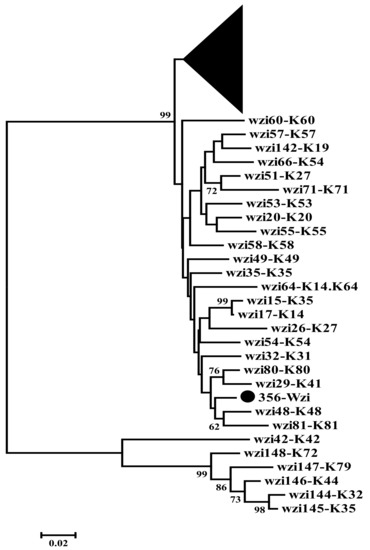
Figure 1.
Phylogenetic analysis of wzi nucleotide sequences of the Klebsiella strain CEMTC 356 and reference Klebsiella strains of the 77 K-types. Each serotype is denoted by the letter K and the number following it [5]. The wzi sequence of the investigated CEMTC 356 is marked with a black circle. The compressed subtree includes more distant reference sequences. The maximum-likelihood method was used to construct the tree with a bootstrap equal to 1000. Statistical support above 70% is shown at the nodes.
The KP8 phage formed clear plaques, with a diameter of about 1–1.5 mm on a lawn of the host strain (Figure 2A). Electron microscopy revealed phage capsids with a diameter of 50–55 nm connected with a short tail of approximately 16 nm in length (Figure 2B). The morphology and size of the phage particles corresponded to those of podoviruses [31]. The host range of phage KP8 was determined using 74 Enterobacteria strains (Table S1), including 63 Klebsiella strains, but it was only specific to K. pneumoniae CEMTC 356.
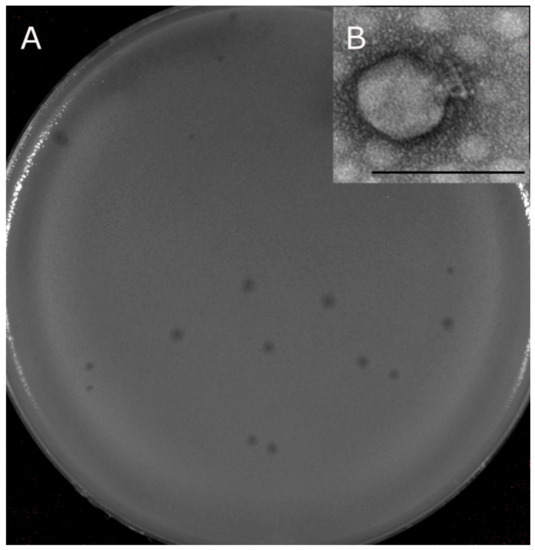
Figure 2.
(A) Plaques formed by phage KP8 on a lawn of the host strain CEMTC 356; (B) electron microphotograph of phage particle. The scale corresponds to 100 nm.
3.2. Biological Properties of KP8
A one-step growth experiment revealed a latent period of 15 min with a burst size of ~40 phage particles per infected cell (Figure 3A). The multistep bacterial killing curve for phage KP8 showed that the amount of living bacteria decreased dramatically in 2 h after infection, and afterwards slowly increased (Figure 3B). The results indicated that phage KP8 was a lytic phage.
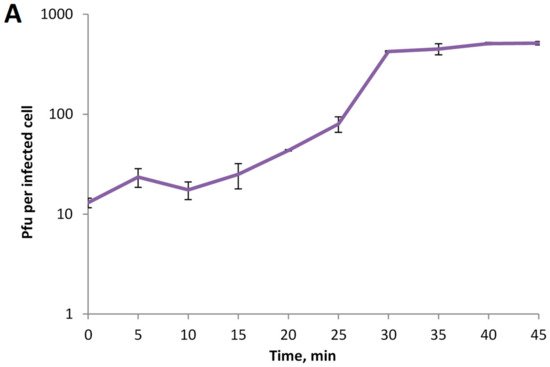
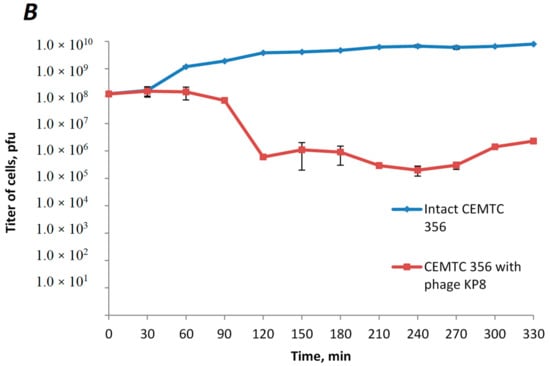
Figure 3.
Biological properties of phage KP8. (A) One-step growth curve of phage KP8; (B) multistep bacterial killing curve of phage KPM16; intact growing K. pneumoniae CEMTC 356 cells were used as a control.
3.3. Genome Structure
The size of the KP8 genome was 73,679 bp, with a 404 bp length of the terminal direct repeats (Figure 4). The GC-content in the KP8 genome was 44.2%, in contrast to its host, Klebsiella pneumoniae, which has a GC-content of about 57%. The KP8 genome demonstrated the highest similarity to the genomes of Enquatrovirus and Gamaleyavirus phages, which are N4-like podoviruses. The nucleotide sequence identity of the KP8 genome to those of phages representing these two genera was 46.6% for Escherichia phage N4 (Enquatrovirus), and 46.8% for phage G7C (Gamaleyavirus). In addition, the KP8 genome showed gene synteny typical for the members of these two genera (Figure 5) and contained the gene, encoding a large virion-encapsulated RNA polymerase (vRNAP).

Figure 4.
A schematic genomic map of bacteriophage KP8. A number of genes with proposed functions are noted.
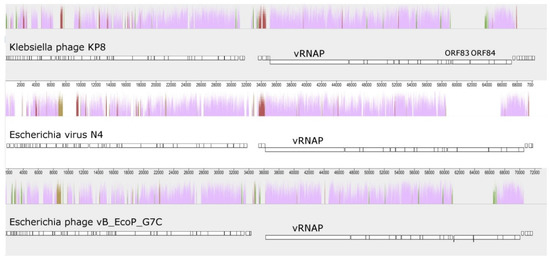
Figure 5.
Gene synteny of KP8, Escherichia virus N4, and Escherichia phage vB_EcoP_G7C genomes. The alignment was performed using Mauve software with default parameters. Horizontal white bars match the genomic sequences with rectangles corresponding to the ORFs. The height of the colored peaks in the chromatograms represents the level of similarity in the particular region between aligned genomes. The light purple regions in the chromatograms are similar in all genomes. Brown, green, and marsh-colored regions correspond to KP8/N4, KP8/G7C, and N4/G7C similarity of genomes, respectively.
The genome of KP8 comprised 97 putative ORFs and most of them were organized into two large functional clusters. The first cluster (ORF1–ORF67) contained early and middle genes, while the second cluster (ORF68–ORF87) included late genes that were transcribed in the opposite direction (Figure 4). In addition, ten hypothetical ORFs were located at the 3’ end of the KP8 genome, which was transcribed in the right direction. ATG was proposed as a start-codon for 94 ORFs and only three ORFs used GTG as a start-codon. Four potential promoters (P1–P4) were found at the 5’ end of the KP8 genome. Notably, P3 and P4 sequences were revealed before the genes, encoding RNA-polymerase 1 subunits A and B, respectively (Table 1). A potential rho-independent terminator was identified at the end of the first cluster (Table 1).

Table 1.
Putative regulatory elements in the genome of Klebsiella phage KP8.
3.4. Predicted Gene Products
From 97 putative ORFs of KP8, 40 ORFs encoded products with predicted functions, and 57 ORFs encoded hypothetical proteins. ORFs providing RNA and DNA synthesis were identified in the first cluster of genes. The RNAP1 subunit A, a predicted analog of gp2 in the N4 phage, was encoded by the ORF5 located right after the putative promoter P3, while the RNAP1 subunit B was encoded by the ORF22 that was located after the putative promoter P4. In a group of putative ORFs located between ORF5 and ORF22, two ORFs were responsible for the predicted functions—the GTG-binding domain (gp14) and ADP-ribosylglycohydrolase (gp19), respectively. ORF25 (RNAP2) was followed by ORF26, encoding a potential capsid decorating protein with an Ig-like domain (gp26), which was found in the first cluster that is usual for N4-like phages. The sub-cluster of ORFs associated with DNA synthesis was typically located downstream the sub-cluster of ORFs providing RNA synthesis (Figure 4, Table 2). In addition, six tRNA genes were grouped at the 3’ end of the first cluster and four of them were identified as the asparagine (GTT), proline (CCA), leucine (CAG), and glutamine (TTG) tRNA genes (Figure 4).

Table 2.
Genes with proposed functions in the genome of bacteriophage KP8.
Within the second cluster, ORFs encoding vRNAP and structural proteins and ORFs associated with the assembly of phage capsids, DNA maturation, and the outburst of mature phage particles were predicted. A group of predicted structural KP8 proteins was similar to that of N4 and G7C phages (Figure 5, Table 2), except gp83 and gp84. Both products were annotated as predicted tail fiber proteins with hydrolyzing activity domains (Table 2). Notably, none of the proteins similar to gp83 were found in known N4-like phages. The gp83 of KP8 showed the highest similarity (23% of identity per 78% coverage) to the tailspike protein [YP_009153195] of Klebsiella myovirus KP64-1 [NC_027399.1]. Previously, depolymerizing activity of this tail spike protein has been experimentally confirmed [32]. In the gp84 of KP8, the SGNH hydrolase domain (aa 340–579) was predicted using InterProScan. The N-terminal domain was similar to that of tail fiber proteins of several N4-like phages and, presumably, this region is responsible for the attachment of the tail fiber to the phage capsid.
Transmembrane helical domains and signal sequences were found in 13 of the predicted proteins (Table S2), and the majority of appropriate ORFs encoded hypothetical proteins, except ORF78, ORF79, and ORF80, which were associated with the release of phages from the cell. According to our analysis, the N-acetylmuramidase (ORF79) contained a signal sequence and this protein was proposed to be SAR-endolysin. Notably, four transmembrane domains were predicted in a hypothetical protein encoded by ORF71. As this ORF was located in the cluster of genes encoding structural proteins, we suppose that it might encode a structural protein.
3.5. Proteomic Analysis
In addition, a proteomic analysis of virion proteins was carried out. At least nine protein bands were identified using SDS-PAGE (Figure 6). Seven protein bands were subjected to MALDI-TOF analysis. The obtained results confirmed the genomic annotation of vRNAP and six structural proteins with the predicted major coat protein, portal protein, capsid decoration protein, and hypothetical structural protein, and unusual gp83 and gp84 (Table 2). Some putative structural proteins were not identified by this method, which was probably due to their relatively low abundance.
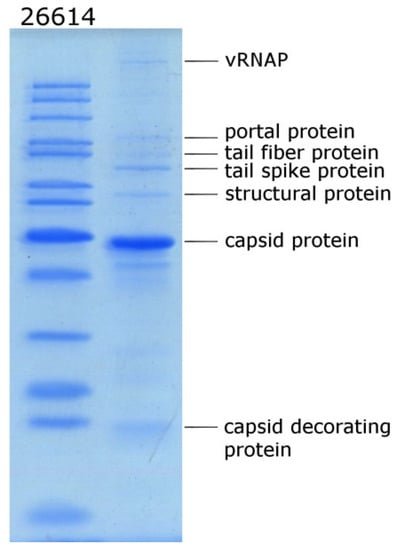
Figure 6.
SDS-PAGE of purified bacteriophage KP8 particles, followed by staining with Coomassie brilliant blue R250. Lane 26614 is unstained protein standards (Thermo Fisher Scientific, USA).
3.6. Phylogenetic Analysis of the KP8 Complete Genome
To estimate the taxonomic position of Klebsiella bacteriophage KP8, a phylogenetic analysis of the complete KP8 genome, along with the most similar phage genomes, was carried out. It was revealed that on the phylogenetic tree of the N4-like group of phages, the KP8 genome formed a distinct branch within the clade, which included the members of Enquatrovirus and Gamaleyavirus genera, besides KP8 (Figure 7). Importantly, the KP8 genome did not group with the known Klebsiella phage Pylas, which probably belongs to the Ithacavirus genus (Figure 7).
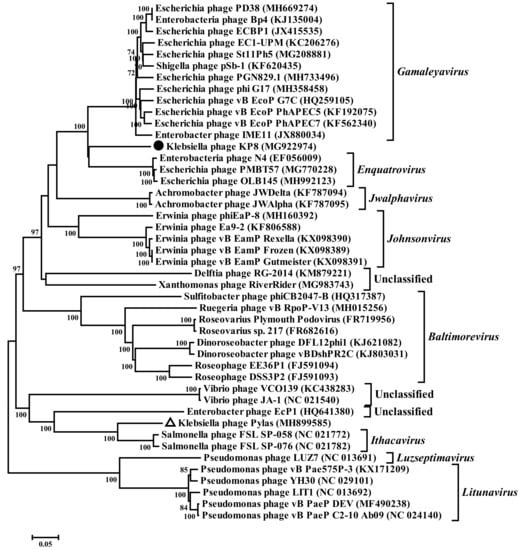
Figure 7.
Phylogenetic analysis of the complete genome of KP8 bacteriophage along with the most similar genomes. GenBank identifiers (gi) for the sequences are shown in parentheses. The maximum-likelihood method was used to construct the tree. Statistical support above 70% is shown at the nodes. The sequence ID of the genome of the investigated KP8 phage is marked with a black circle. The sequence ID of the Klebsiella phage Pylas is marked with a triangle.
As the most similar genomes of N4-like phages belonged to the members of Enquatrovirus and Gamaleyavirus genera, the average evolutionary divergence over sequence pairs was estimated between the KP8 genome and phage genomes of Enquatrovirus, and Gamaleyavirus genera, respectively. As a result, the evolutionary divergence of KP8/Enquatrovirus was 0.466 substitutions per site (substitutions/site) and that of KP8/Gamaleyavirus was 0.447 substitutions/site. This was quite similar to the evolutionary divergence between Enquatrovirus and Gamaleyavirus genera (0.468 substitutions/site). Note that the evolutionary divergence within Enquatrovirus and Gamaleyavirus genera was 0.017 and 0.117 substitutions/site, respectively. As the evolutionary divergence between KP8 and the Klebsiella phage Pylas was high, with a value of 0.963 substitutions/site, the KP8 phage might be the first member of a new genus within N4-like phages and this genus did not include Klebsiella phage Pylas.
To confirm the result of the phylogenetic analysis of complete genomes, amino acid sequences of some predicted proteins encoded by the KP8 genome (primase, ORF55; vRNAP, ORF68; major coat protein, ORF74; terminase, ORF86) were compared with the most similar phage protein sequences, downloaded from the Genbank database (Figure S1). All visualized phylogenetic protein trees confirmed the position of the KP8 proteins on a distinct branch in the clade containing appropriate proteins of phages from the Enquatrovirus and Gamaleyavirus genera. The obtained data suggested that Klebsiella phage KP8 differs from other similar phages and may represent a new genus within the N4-like phages.
4. Discussion
N4-like podoviruses comprise a unique group among bacteriophages because their virions include the giant vRNAP that enters the host-cell during phage infection and, therefore, N4-like phages do not require the host RNA-polymerase for transcription of their early genes [25,33]. Over the last decade, tens of N4-like phages have been discovered and their genomes have been sequenced and characterized [33,34,35,36,37,38,39,40,41,42,43,44,45,46]. They have conserved genome organization, including two large clusters of early-middle and late genes, transcribed in opposite orientations, and a group of usually short ORFs with unknown functions, whose number varies between different N4-like phages. Currently, N4-like phages capable of infecting various Alpha-, Beta-, and Gamma-proteobacteria have been described [37,40,42,43,44,45,46] and many hosts from the Gamma-proteobacteria class are human pathogens, including the ESKAPE group. This fact explains the interest in N4-like phages, all of which are strictly lytic phages.
K. pneumoniae, which is currently recognized as super-bacteria, is a host of two different Klebsiella N4-like phages: Klebsiella phage Pylas, isolated in the USA, Texas [MH899585]; and the novel KP8 phage described in this article. The KP8 phage is a lytic phage infecting K. pneumoniae CEMTC 356 that does not belong to the most virulent K1 and K2 capsular types. The KP8 genome shows gene synteny typical for the group of N4-like phages and contains the gene encoding vRNAP. According to phylogenetic analysis of the complete KP8 genome, along with the most similar phage genomes, it was revealed that KP8 forms a distinct branch within the N4-like group of phages. Notably, the evolutionary divergence between KP8 and Klebsiella phage Pylas was higher than that between KP8 and other genera, including Enquatrovirus and Gamaleyavirus. This fact confirmed that KP8 and Klebsiella phage Pylas definitely belongs to different genera and K. pneumoniae, along with Escherichia coli and Erwinia amylovora, can be infected with N4-like phages from different genera. Finally, taking into consideration (i) the unique feature of all N4-like phages—the presence of vRNAP in a capsid that distinguishes this group of phages from the phage world; (ii) the comparatively high genetic divergence of N4-like pages, which currently form more than ten genera; and (iii) the wide range of hosts for these phages, we strongly support the assignment of N4-like phages to a separate subfamily, presumably called “Enquartavirinae”, as was suggested previously [47].
Supplementary Materials
The following are available online at https://www.mdpi.com/1999-4915/11/12/1115/s1, Figure S1: Phylogenetic analysis of the proteins of KP8 bacteriophage along with the similar proteins. (A) major coat protein; (B) primase; (C) virion RNAP; (D) terminase subunit A, respectively. GenBank identifiers (gi) for the sequences are shown in parentheses. The maximum-likelihood method was used to construct the tree. Statistical support above 70% is shown at the nodes. The GenBank IDs of the appropriate proteins of the investigated KP8 phage are marked with black circles. Table S1: Enterobacteria strains tested for sensitivity to bacteriophage KP8. Table S2: Putative proteins, containing transmembrane helical domains and signal sequences.
Author Contributions
Conceptualization, V.M., I.B. (Igor Babkin) and N.T.; Data curation, A.T., I.B. (Igor Babkin) and O.B.; Formal analysis, I.B. (Igor Babkin) and I.B. (Ivan Baykov); Funding acquisition, N.T. and I.B. (Ivan Baykov); Investigation, T.U., A.B., E.R. and E.Z.; Project administration, V.M. and N.T.; Resources, Y.K.; Supervision, N.T.; Visualization, V.M. and I.B. (Igor Babkin); Writing—original draft, V.M., and I.B. (Igor Babkin); Writing—review & editing, V.M., and N.T.
Funding
Investigation of Klebsiella bacteriophage KP8 genome and biological properties was funded by RFBR project 18-29-08015. Mass-spectrometry identification of structural proteins was funded by RFBR project 18-34-00636. Collection EMTC of ICBFM is supported by Russian State funded budget project of ICBFM SB RAS # AAAA-A17-117112320049-9.
Acknowledgments
The authors wish to thank G.B. Kaverina for excellent technical support.
Conflicts of Interest
The authors declare no conflicts of interest. The funders had no role in the design of the study; in the collection, analyses, or interpretation of data; in the writing of the manuscript, or in the decision to publish the results.
References
- Vading, M.; Nauclér, P.; Kalin, M.; Giske, C.G. Invasive infection caused by Klebsiella pneumoniae is a disease affecting patients with high comorbidity and associated with high long-term mortality. PLoS ONE 2018, 13, 1–13. [Google Scholar] [CrossRef] [PubMed]
- Yeh, K.M.; Kurup, A.; Siu, L.K.; Koh, Y.L.; Fung, C.P.; Lin, J.C.; Chen, T.L.; Chang, F.Y.; Koh, T.H. Capsular serotype K1 or K2, rather than magA and rmpA, is a major virulence determinant for Klebsiella pneumoniae liver abscess in Singapore and Taiwan. J. Clin. Microbiol. 2007, 45, 466–471. [Google Scholar] [CrossRef] [PubMed]
- Pan, Y.J.; Lin, T.L.; Chen, C.T.; Chen, Y.Y.; Hsieh, P.F.; Hsu, C.R.; Wu, M.C.; Wang, J.T. Genetic analysis of capsular polysaccharide synthesis gene clusters in 79 capsular types of Klebsiella spp. Sci. Rep. 2015, 5, 1–10. [Google Scholar] [CrossRef] [PubMed]
- Salerno, A.; Delétoile, A.; Lefevre, M.; Ciznar, I.; Krovacek, K.; Grimont, P.; Brisse, S. Recombining population structure of Plesiomonas shigelloides (Enterobacteriaceae) revealed by multilocus sequence typing. J. Bacteriol. 2007, 189, 7808–7818. [Google Scholar] [CrossRef]
- Brisse, S.; Passet, V.; Haugaard, A.B.; Babosan, A.; Kassis-Chikhani, N.; Struve, C.; Decré, D. wzi gene sequencing, a rapid method for determination of capsular type for Klebsiella strains. J. Clin. Microbiol. 2013, 51, 4073–4078. [Google Scholar] [CrossRef]
- Munoz-Price, L.S.; Poirel, L.; Bonomo, R.A.; Schwaber, M.J.; Daikos, G.L.; Cormican, M.; Cornaglia, G.; Garau, J.; Gniadkowski, M.; Hayden, M.K.; et al. Clinical epidemiology of the global expansion of Klebsiella pneumoniae carbapenemases. Lancet Infect. Dis. 2013, 13, 785–796. [Google Scholar] [CrossRef]
- Wei, J.; Wenjie, Y.; Ping, L.; Na, W.; Haixia, R.; Xuequn, Z. Antibiotic resistance of Klebsiella pneumoniae through β-arrestin recruitment-induced β-lactamase signaling pathway. Exp. Ther. Med. 2018, 15, 2247–2254. [Google Scholar] [CrossRef]
- Pitout, J.D.; Nordmann, C.; Poirel, L. Carbapenemase-Producing Klebsiella pneumoniae, a Key Pathogen Set for Global Nosocomial Dominance. Antimicrob. Agents Chemother. 2015, 59, 5873–5884. [Google Scholar] [CrossRef]
- Anderson, D.J.; Moehring, R.W.; Sloane, R.; Schmader, K.E.; Weber, D.J.; Fowler, V.G., Jr.; Smathers, E.; Sexton, D.J. Bloodstream infections in community hospitals in the 21st century: A multicenter cohort study. PLoS ONE 2014, 9, 1–10. [Google Scholar] [CrossRef]
- Iredell, J.; Brown, J.; Tagg, K. Antibiotic resistance in Enterobacteriaceae: Mechanisms and clinical implications. BMJ 2016, 352, 1–19. [Google Scholar] [CrossRef]
- Tamura, K.; Stecher, G.; Peterson, D.; Filipski, A.; Kumar, S. MEGA 6: Molecular Evolutionary Genetics Analysis version 6.0. Mol. Biol. Evol. 2013, 30, 2725–2729. [Google Scholar] [CrossRef] [PubMed]
- Morozova, V.; Kozlova, Y.; Shedko, E.; Kurilshikov, A.; Babkin, I.; Tupikin, A.; Yunusova, A.; Chernonosov, A.; Baykov, I.; Kondratov, I. Lytic Bacteriophage PM16 Specific for Proteus mirabilis: A Novel Member of the genus phiKMVvirus. Arch. Virol. 2016, 161, 2457–2472. [Google Scholar] [CrossRef] [PubMed]
- Sambrook, J.; Russell, D.W. Molecular Cloning: A Laboratory Manual, 3rd ed.; Cold Spring Harbor Laboratory Press: Cold Spring Harbor, NY, USA, 2001; pp. 187–303. [Google Scholar]
- Kropinski, A.M.; Mazzocco, A.; Waddell, T.E.; Lingohr, E.; Johnson, R.P. Enumeration of bacteriophages by double agar overlay plaque assay. In Bacteriophages: Methods and Protocols; Clokie, M.R.J., Kropinski, A.M., Eds.; Humana Press: New York, NY, USA, 2009; pp. 69–76. [Google Scholar]
- Pajunen, M.; Kiljunen, S.; Skurnik, M. Bacteriophage phiYeO3-12, specific for Yersinia enterocolitica serotype O:3, is related to coliphages T3 and T7. J. Bacteriol. 2000, 182, 5114–5120. [Google Scholar] [CrossRef] [PubMed]
- Heo, Y.J.; Lee, Y.R.; Jung, H.H.; Lee, J.; Ko, G.; Cho, Y.H. Antibacterial Efficacy of phages against Pseudomonas aeruginosa infections in mice and Drosophila melanogaster. Antimicrob Agents Chemother. 2009, 53, 2469–2474. [Google Scholar] [CrossRef] [PubMed]
- Kutter, E. Phage Host Range and Efficiency of Plating. In Bacteriophages: Methods and Protocols; Clokie, M.R.J., Kropinski, A.M., Eds.; Humana Press: New York, NY, USA, 2009; pp. 141–149. [Google Scholar]
- O’Flaherty, S.; Coffey, A.; Edwards, R.; Meaney, W.; Fitzgerald, G.F.; Ross, R.P. Genome of staphylococcal phage K: A new lineage of Myoviridae infecting gram-positive bacteria with a low GC content. J. Bacteriol. 2004, 186, 2862–2871. [Google Scholar] [CrossRef] [PubMed]
- Aziz, R.K.; Bartels, D.; Best, A.A.; DeJongh, M.; Disz, T.; Edwards, R.A.; Formsma, K.; Gerdes, S.; Glass, E.M.; Kubal, M.; et al. The RAST Server: Rapid Annotations using Subsystems Technology. BMC Genomics 2008, 9, 75. [Google Scholar] [CrossRef]
- Jones, P.; Binns, D.; Chang, H.-Y.; Fraser, M.; Li, W.; McAnulla, C.; McWilliam, H.; Maslen, J.; Mitchell, A.; Nuka, G.; et al. InterProScan 5: Genome-scale protein function classification. Bioinformatics 2014, 30, 1236–1240. [Google Scholar] [CrossRef]
- Remmert, M.; Biegert, A.; Hauser, A.; Söding, J. HHblits: Lightning-fast iterative protein sequence searching by HMM-HMM alignment. Nat. Methods 2011, 9, 173–175. [Google Scholar] [CrossRef]
- Lowe, T.M.; Chan, P.P. tRNAscan-SE On-line: Integrating search and context for analysis of transfer RNA genes. Nucleic Acids Res. 2012, 44, 54–57. [Google Scholar] [CrossRef]
- Laslett, D.; Canback, B. ARAGORN, a program to detect tRNA genes and tmRNA genes in nucleotide sequences. Nucleic Acids Res. 2004, 32, 11–16. [Google Scholar] [CrossRef]
- Käll, L.; Krogh, A.; Sonnhammer, E.L. Advantages of combined transmembrane topology and signal peptide prediction—The Phobius web server. Nucleic Acids Res. 2007, 35, W429–W432. [Google Scholar] [CrossRef] [PubMed]
- Haynes, L.L.; Rothman-Denes, L.B. N4 virion RNA polymerase sites of transcription initiation. Cell 1985, 41, 597–605. [Google Scholar] [CrossRef]
- Lu, G.; Moriyama, E.N. Vector NTI, a balanced all-in-one sequence analysis suite. Brief. Bioinform. 2004, 5, 378–388. [Google Scholar] [CrossRef] [PubMed]
- Darling, A.C.; Mau, B.; Blattner, F.R.; Perna, N.T. Mauve: Multiple alignment of conserved genomic sequence with rearrangements. Genome Res. 2004, 14, 1394–1403. [Google Scholar] [CrossRef]
- Phillips, J.L.; Gnanakaran, S. BioEdit: An important software for molecular biology. Proteins Struct Funct. Bioinform. 2015, 83, 46–65. [Google Scholar] [CrossRef]
- Shevchenko, A.; Jensen, O.N.; Podtelejnikov, A.V.; Sagliocco, F.; Wilm, M.; Vorm, O.; Mortensen, P.; Shevchenko, A.; Boucherie, H.; Mann, M. Linking genome and proteome by mass spectrometry: Large-scale identification of yeast proteins from two dimensional gels. Proc. Natl. Acad. Sci. USA 1996, 93, 14440–14445. [Google Scholar] [CrossRef]
- Niedermeyer, T.H.J.; Strohalm, M. mMass as a Software Tool for the Annotation of Cyclic Peptide Tandem Mass Spectra. PLoS ONE 2012, 7, e44913. [Google Scholar] [CrossRef]
- Ackermann, H.W. Phage Classification and Characterization. In Bacteriophages: Methods and Protocols; Clokie, M.R.J., Kropinski, A.M., Eds.; Humana Press: New York, NY, USA, 2009; pp. 127–140. [Google Scholar] [CrossRef]
- Pan, Y.; Lin, T.; Lin, Y.; Su, P.; Chen, C.; Hsieh, P.; Hsu, C.; Chen, C.; Hsieh, Y.; Wang, J. Identification of capsular types in carbapenem-resistant Klebsiella pneumoniae strains by wzc sequencing and implications for capsule depolymerase treatment. Antimicrob. Agents Chemother. 2015, 59, 1038–1047. [Google Scholar] [CrossRef]
- Ohmori, H.; Haynes, L.L.; Rothman-Denes, L.B. Structure of the ends of the coliphage N4 genome. J. Mol. Biol. 1988, 202, 1–10. [Google Scholar] [CrossRef]
- Kulikov, E.; Kropinski, A.M.; Golomidova, A.; Lingohr, E.; Govorun, V.; Serebryakova, M.; Prokhorov, N.; Letarova, M.; Manykin, A.; Strotskaya, A.; et al. Isolation and characterization of a novel indigenous intestinal N4-related coliphage vB_EcoP_G7C. Virology 2012, 426, 93–99. [Google Scholar] [CrossRef]
- Nho, S.W.; Ha, M.A.; Kim, K.S.; Kim, T.H.; Jang, H.B.; Cha, I.S.; Park, S.B.; Kim, Y.K.; Jung, T.S. Complete genome sequence of the bacteriophages ECBP1 and ECBP2 isolated from two different Escherichia coli strains. J. Virol. 2012, 86, 12439–12440. [Google Scholar] [CrossRef][Green Version]
- Gan, H.M.; Sieo, C.C.; Tang, S.G.; Omar, A.R.; Ho, Y.W. The complete genome sequence of EC1-UPM, a novel N4-like bacteriophage that infects Escherichia coli O78:K80. Virol. J. 2013, 10, 308. [Google Scholar] [CrossRef] [PubMed]
- Jun, J.W.; Yun, S.K.; Kim, H.J.; Chai, J.Y.; Park, S.C. Characterization and complete genome sequence of a novel N4-like bacteriophage, pSb-1 infecting Shigella boydii. Res. Microbiol. 2014, 165, 671–678. [Google Scholar] [CrossRef] [PubMed]
- Tsonos, J.; Oosterik, L.H.; Tuntufye, H.N.; Klumpp, J.; Butaye, P.; De Greve, H.; Hernalsteens, J.P.; Lavigne, R.; Goddeeris, B.M. A cocktail of in vitro efficient phages is not a guarantee for in vivo therapeutic results against avian colibacillosis. Vet. Microbiol. 2014, 171, 470–479. [Google Scholar] [CrossRef] [PubMed]
- Fan, H.; Fan, H.; An, X.; Huang, Y.; Zhang, Z.; Mi, Z.; Tong, Y. Complete genome sequence of IME11, a new N4-like bacteriophage. J. Virol. 2012, 86, 13861. [Google Scholar] [CrossRef] [PubMed][Green Version]
- Wittmann, J.; Dreiseikelmann, B.; Rohde, M.; Meier-Kolthoff, J.P.; Bunk, B.; Rohde, C. First genome sequences of Achromobacter phages reveal new members of the N4 family. Virol J. 2014, 11, 14. [Google Scholar] [CrossRef]
- Park, J.; Lee, G.M.; Kim, D.; Park, D.H.; Oh, C.S. Characterization of the lytic bacteriophage phiEaP-8 effective against both Erwinia amylovora and Erwinia pyrifoliae causing severe diseases in apple and pear. Plant. Pathol. J. 2018, 34, 445–450. [Google Scholar] [CrossRef]
- Ankrah, N.Y.; Budinoff, C.R.; Wilson, W.H.; Wilhelm, S.W.; Buchan, A. Genome sequence of the Sulfitobacter sp. strain 2047-infecting lytic phage {Phi}CB2047-B. Genome Announc. 2014, 2, e00945-13. [Google Scholar] [CrossRef]
- Chan, J.Z.; Millard, A.D.; Mann, N.H.; Schäfer, H. Comparative genomics defines the core genome of the growing N4-like phage genus and identifies N4-like Roseophage specific genes. Front. Microbiol. 2014, 5, 506. [Google Scholar] [CrossRef]
- Zhao, Y.; Wang, K.; Jiao, N.; Chen, F. Genome sequences of two novel phages infecting marine roseobacters. Environ. Microbiol. 2009, 11, 2055–2064. [Google Scholar] [CrossRef]
- Moreno Switt, A.I.; Orsi, R.H.; den Bakker, H.C.; Vongkamjan, K.; Altier, C.; Wiedmann, M. Genomic characterization provides new insight into Salmonella phage diversity. BMC Genomics 2013, 14, 481. [Google Scholar] [CrossRef] [PubMed]
- Ceyssens, P.J.; Brabban, A.; Rogge, L.; Lewis, M.S.; Pickard, D.; Goulding, D.; Dougan, G.; Noben, J.P.; Kropinski, A.; Kutter, E.; et al. Molecular and physiological analysis of three Pseudomonas aeruginosa phages belonging to the “N4-like viruses”. Virology 2010, 405, 26–30. [Google Scholar] [CrossRef] [PubMed]
- Wittmann, J.; Klumpp, J.; Moreno Switt, A.I.; Yagubi, A.; Ackermann, H.W.; Wiedmann, M.; Svircev, A.; Nash, J.H.; Kropinski, A.M. Taxonomic reassessment of N4-like viruses using comparative genomics and proteomics suggests a new subfamily—“Enquartavirinae”. Arch. Virol. 2015, 160, 3053–3062. [Google Scholar] [CrossRef] [PubMed]
© 2019 by the authors. Licensee MDPI, Basel, Switzerland. This article is an open access article distributed under the terms and conditions of the Creative Commons Attribution (CC BY) license (http://creativecommons.org/licenses/by/4.0/).